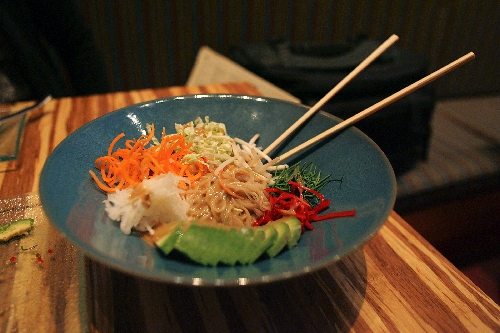China Poblano restaurant mixes Mexico, China for multicultural experience
In 1609, the beautiful Asian Princess Mirnha was taken prisoner. Her pirate captors intended to sell her as a slave to the Viceroy of Mexico, who was seeking gorgeous women to grace his palace. When she arrived in Acapulco on a Chinese ship, people were awestruck by her exotic looks and fantastic clothes detailed with complex embroidery and dazzling sequins.
Mexican women soon imitated her style, which became known as China Poblana.
Cleverly, chef Jose Andres pays homage to this China-meets-Mexico legend with his most recent concept restaurant.
China Poblano, on the second floor of The Cosmopolitan of Las Vegas, embraces both cultures and delivers a hybrid dining experience. Recognized for his avant-garde approach to food and dining, the Spanish born and trained chef does not disappoint with his latest creation.
The restaurant is a James Beard Foundation semifinalist as best new restaurant for 2011 -- the only Las Vegas restaurant to receive the honor.
Theoretically, China Poblano should be filled with contradictions; the raucous, colorful world of Mexico should stand in stark contrast with the Zen subtleties of China.
Instead, they produce an unforgettable adventure for the palate.
A hand-pulled noodle station and a handmade tortilla station grace the Buddha-shaped entrance and set the tone for a distinctive dining experience.
Immediately, the diners's attention is drawn past the statues seated on stadium benches to a giant head suspended on the back wall. Images of faces projected on the head fade from one to another capturing at once the diversity and unity of humanity and simultaneously resolving the conundrum of China Poblano.
The architecture and decor create a multicultural ambience where Chinese red lanterns are juxtaposed with traditional Mexican masks, and images of Chairman Mao and Frida Kahlo are projected on the walls in unison.
Important to both cultures, wheels fill the ceiling invoking thoughts of Chinese bicycles and Mexican pushcarts. The servers, dressed in black Mao-styled jackets with symbols from both countries, are informed and attentive.
Every detail reflects the concept.
The menu offers small dishes from China and Mexico and several creative selections that fuse the cuisines and truly deliver the essence of La China Poblano.
Like the princess, Andres creates a new enviable style of cooking and eating.
Most dishes offer a story.
From the dim sum menu, "When Pigs Fly" wraps a delicate bun around succulent barbecue pork with an end result so light it could fly.
Even more memorable, the traditional sui mai is hand-packed with shrimp and pork, water chestnuts, mushrooms and peanuts, and dusted with gold.
The levels of flavor in this dish release individually, leaving a subtle peanut taste as a final lasting memory.
China Poblano offers many noodle dishes.
Beautifully composed and presented, "Beijing Glass" combines the colors and textures of jicama, avocado, Chinese cabbage, sprouts and micro chives, and enhanced with the smoky richness of sesame dressing. It's another delicious contradiction -- light and satiating.
Noodles may have their own spotlight both in the restaurant and on the menu, but vegetables have never found a better gastronomic home than the twenty vegetable fried rice.
The dish arrives in a simple ceramic bowl filled to the top with micro carrots, thinly sliced cauliflower, mushrooms, greens, snow peas, jicama and 14 other fresh vegetables, and it leaves completely empty.
Not a grain of this amazing rice is to be wasted.
"Like Water for Chocolate" pays tribute to a recipe in the book by the same name.
Perfectly fried quail shares the plate with exotic dragon fruit, rose petals and chestnuts.
With this dish, Andres brings the words to life.
Simultaneously delicate and savory, it provides a climax to the already elevated dinner.
The China Poblano story would be incomplete without a fitting conclusion, and the menu offers six delicious options.
However, there is no more spectacular dessert than the "Chocolate Terra Cotta Warrior." Each day, the pastry chef creates chocolate molds of the terra cotta warriors buried with Chinese emperors. The molds are filled with chocolate mousse and laid upon a bed of ginger ice cream and banana slices. The warrior is then surrounded by edible flowers and chocolate crumb dirt. The contrast in textures -- hard chocolate, light mousse, creamy ginger -- offers the diner a perfect treat and a memorable end to the feast of small dishes.
Christopher Columbus may have dreamed of connecting the East and the West, but chef Jose Andres found a way to unite them perfectly.
R-Jeneration
REVIEW
China Poblano
The Cosmopolitan of Las Vegas, 3708 Las Vegas Boulevard South
689-7900



















